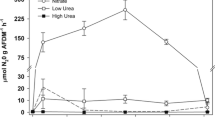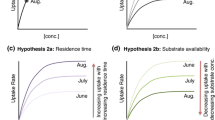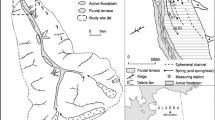Abstract
Groundwater discharge is increasingly recognized as a significant source of nutrient input to coastal waters, relative to surface water inputs. There remains limited information, however, on the extent to which nutrients and organic matter from each of these two flowpaths influence the functional responses of coastal microbial communities. As such, this study determined dissolved organic carbon (DOC) and nutrient concentrations of surface water runoff and groundwater from both an urbanized and a relatively pristine forested drainage basin near Myrtle Beach, South Carolina, and quantified the changes in production rates and biomass of phytoplankton and bacterioplankton in response to these inputs during two microcosm incubation experiments (August and October, 2011). Rainwater in the urbanized basin that would otherwise enter the groundwater appeared to be largely rerouted into the surface flowpath by impervious surfaces, bypassing ecosystem buffers and filtration mechanisms. Surface runoff from the developed basin was most enriched in nutrients and DOC and yielded the highest production rates of the various source waters upon addition to coastal waters. The metabolic responses of phytoplankton and bacterioplankton were generally well predicted as a function of initial chemical composition of the various source waters, though more so with bacterial production. Primary and bacterial productivities often correlated at reciprocal time points (24-h measurement of one with the 72-h measurement of the other). These results suggest human modification of coastal watersheds enhances the magnitude of dissolved constituents delivered to coastal waters as well as alters their distributions between surface and groundwater flowpaths, with significant implications for microbial community structure and function in coastal receiving waters.






Similar content being viewed by others
References
Aelion, C.M., J.N. Shaw, and M. Wahl. 1997. Impact of suburbanization on ground water quality and denitrification in coastal aquifer sediments. Journal of Experimental Marine Biology and Ecology 213: 31–51.
Agardy, T., and J. Alder. 2005. Coastal systems. In Millennium ecosystem assessment: Current state and trends assessment, ed. R. Hassan, R. Scholes, and N. Ash, 513–548. Washington: Island Press.
Allen, J., and K. Lu. 2003. Modeling and prediction of future urban growth in the Charleston region of South Carolina: A GIS-based integrated approach. Conservation Ecology 8: 2.
Àlvarez-Gòngora, C., and J.A. Herrera-Silveira. 2006. Variations of phytoplankton community structure related to water quality trends in a tropical karstic coastal zone. Marine Pollution Bulletin 52: 48–60.
Arar, E.J., and G.B. Collins. 1997. Method 445.0: In vitro determination of chlorophyll a and pheophytin a in marine and freshwater algae by fluorescence. United States Environmental Protection Agency, Office of Research and Development, National Exposure Research Laboratory.
Arrigo, K.R., and C.W. Brown. 1996. Impact of chromophoric dissolved organic matter on UV inhibition of primary productivity in the sea. Marine Ecology Progress Series 140: 207–216.
Azam, F., T. Fenchel, J.G. Field, J.S. Gray, L.A. Meyer-Reil, and F. Thingstad. 1982. The ecological role of water-column microbes in the sea. Marine Ecology Progress Series 10: 257–263.
Basterretxea, G., A. Tovar-Sanchez, A.J. Beck, P. Masquè, H.J. Bokuniewicz, R. Coffey, C.M. Duarte, J. Garcia-Orellana, E. Garcia-Solsona, and L. Martinez-Ribes. 2010. Submarine groundwater discharge to the coastal environment of a Mediterranean island (Majorca, Spain): Ecosystem and biogeochemical significance. Ecosystems 13: 629–643.
Benner, R., and M. Strom. 1993. A critical evaluation of the analytical blank associated with DOC measurements by high-temperature catalytic oxidation. Marine Chemistry 41: 153–160.
Buzzelli, C., Akman, O., Buck, T., Koepfler, E., Morris, J., and Lewitus, A., 2004. Relationships among water-quality parameters from the North Inlet–Winyah Bay National Estuarine Research Reserve, South Carolina. Journal of Coastal Research: 59–74
Crossett, K.M., Culliton, T.J, Wiley, P.C. and T.R. Goodspeed. 2004. Population trends along the coastal United States: 1980–2008. NOAA Coastal Trends Series. Available from: http://oceanservice.noaa.gov/programs/mb/pdfs/coastal_pop_trends_complete.pdf (accessed August 1, 2012)
Daley, R., and S. Brown. 1973. Experimental characterization of lacustrine chlorophyll diagenesis: I. Physiological and environmental effects. Archives of Hydrobiology 72: 277–304.
del Giorgio, P.A., and R.H. Peters. 1994. Patterns in planktonic P:R ratios in lakes: Influence of lake trophy and dissolved organic carbon. Limnology and Oceanography 772–787.
DiDonato, G.T., J.R. Stewart, D.M. Sanger, B.J. Robinson, B.C. Thompson, A.F. Holland, and R.F. Van Dolah. 2009. Effects of changing land use on the microbial water quality of tidal creeks. Marine Pollution Bulletin 58: 97–106.
Downing, J.A., C.W. Osenberg, and O. Sarnelle. 1999. Meta-analysis of marine nutrient-enrichment experiments: Variation in the magnitude of nutrient limitation. Ecology 80: 1157–1167.
Dugdale, R.C., and J.J. Goering. 1967. Uptake of new and regenerated forms of nitrogen in primary productivity. Limnology and Oceanography 12: 196–206.
Eaton, A.D., and Franson, M.A.H.. 2005. Standard methods for the examination of water & wastewater. Amer Public Health Assn.
Epps, T.H., D.R. Hitchcock, A.D. Jayakaran, D.R. Loflin, T.M. Williams, and D.M. Amatya. 2012. Characterization of storm flow dynamics of headwater streams in the South Carolina lower coastal plain. Journal of the American Water Resources Association 49: 76–89.
Garcès, E., G. Basterretxea, and A. Tovar-Sànchez. 2011. Changes in microbial communities in response to submarine groundwater input. Marine Ecology Progress Series 438: 47–58.
Garside, C. 1982. A chemiluminescent technique for the determination of nanomolar concentrations of nitrate and nitrite in seawater. Marine Chemistry 11: 159–167.
Grimm, N.B., S.H. Faeth, N.E. Golubiewski, C.L. Redman, J.G. Wu, X.M. Bai, and J.M. Briggs. 2008. Global change and the ecology of cities. Science 319: 756–760.
Harder, S.V., D.M. Amatya, T.J. Callahan, C.C. Trettin, and J. Hakkila. 2007. Hydrology and water budget for a forested Atlantic coastal plain watershed, South Carolina. Journal of the American Water Resources Association 43: 563–575.
Hitchcock, J.N., S.M. Mitrovic, T. Kobayashi, and D.P. Westhorpe. 2010. Responses of estuarine bacterioplankton, phytoplankton and zooplankton to dissolved organic carbon (DOC) and inorganic nutrient additions. Estuaries and Coasts 33: 78–91.
Holland, A.F., D.M. Sanger, C.P. Gawle, S.B. Lerberg, M.S. Santiago, G.H.M. Riekerk, L.E. Zimmerman, and G.I. Scott. 2004. Linkages between tidal creek ecosystems and the landscape and demographic attributes of their watersheds. Journal of Experimental Marine Biology and Ecology 298: 151–178.
Jahnke, R.A., and D.B. Craven. 1995. Quantifying the role of heterotrophic bacteria in the carbon cycle: A need for respiration rate measurements. Limnology and Oceanography 40: 436–441.
Jansson, M., A.-K. Bergström, P. Blomqvist, and S. Drakare. 2000. Allochthonous organic carbon and phytoplankton/bacterioplankton production relationships in lakes. Ecology 81: 3250–3255.
Jassby, A.D., and T. Platt. 1976. Mathematical formulation of the relationship between photosynthesis and light for phytoplankton. Limnology and Oceanography 21: 540–547.
Kirchman, D.L. 1993 Leucine incorporation as a measure of biomass production by heterotrophic bacteria. In: Kemp, P.F., B.F. Sherr, E.B. Sherr and J.J. Cole (eds) Handbook of methods in aquatic microbial ecology. Lewis Publishers, p 513–517
Kirchman, D. 1994. The uptake of inorganic nutrients by heterotrophic bacteria. Microbial Ecology 28: 255–271.
Kirchman, D., J. Sigda, R. Kapuscinski, and R. Mitchell. 1982. Statistical analysis of the direct count method for enumerating bacteria. Applied and Environmental Microbiology 44: 376–382.
Kirchman, D.L., A.I. Dittel, S.E.G. Findlay, and D. Fischer. 2004. Changes in bacterial activity and community structure in response to dissolved organic matter in the Hudson River, New York. Aquatic Microbial Ecology 35: 243–257.
Kjerfve, B. 1986. Circulation and salt flux in a well mixed estuary. Physics of Shallow Estuaries and Bays 16: 22–29.
Knap, A., A. Michaels, A. Close, H.W. Ducklow, and H. Dickson. 1996. Protocols for the Joint Global Ocean Flux Study (JGOFS) core measurements. Report no. 19, Reprint from the IOC Manuals and Guides no. 29. Bergen: UNESCO.
Koroleff, F. 1983. Simultaneous oxidation of nitrogen and phosphorus compounds by persulfate. Methods of Seawater Analysis 2: 168–169.
Lapointe, B.E., J.D. O'Connell, and G.S. Garrett. 1999. Nutrient couplings between on-site sewage disposal systems, groundwaters, and nearshore surface waters of the Florida Keys. Biodegradation 10: 289–307.
Lawrenz, E., E.M. Smith, and T.L. Richardson. 2013. Spectral irradiance, phytoplankton community composition and primary productivity in a salt marsh estuary, North Inlet, South Carolina, USA. Estuaries and Coasts 36: 347–364.
Lewitus, A.J., E.T. Koepfler, and J.T. Morris. 1998. Seasonal variation in the regulation of phytoplankton by nitrogen and grazing in a salt-marsh estuary. Limnology and Oceanography 43: 636–646.
Mallin, M.A., V.L. Johnson, and S.H. Ensign. 2009. Comparative impacts of stormwater runoff on water quality of an urban, a suburban, and a rural stream. Environmental Monitoring and Assessment 159: 475–491.
Mallin, M.A., K.E. Williams, E.C. Esham, and R.P. Lowe. 2000. Effect of human development on bacteriological water quality in coastal watersheds. Ecological Applications 10: 1047–1056.
Moore, W.S. 1999. The subterranean estuary: A reaction zone of ground water and sea water. Marine Chemistry 65: 111–125.
Nussbaum, J.C. 1990. Urban storm water runoff and ground-water quality. Office of the Administrator, United States Environmental Protection Agency
Paerl, H.W., J. Dyble, P.H. Moisander, R.T. Noble, M.F. Piehler, J.L. Pinckney, T.F. Steppe, L. Twomey, and L.M. Valdes. 2003. Microbial indicators of aquatic ecosystem change: Current applications to eutrophication studies. FEMS Microbiology Ecology 46: 233–246.
Paul, M.J., and J.L. Meyer. 2001. Streams in the urban landscape. Annual Review of Ecology and Systematics 32: 333–365.
Pèrez, A.P., M.M. Diaz, M.A. Ferraro, G.C. Cusminsky, and H.E. Zagarese. 2003. Replicated mesocosm study on the role of natural ultraviolet radiation in high CDOM, shallow lakes. Photochemical and Photobiological Sciences 2: 118–123.
Pitt, R., S. Clark, and R. Field. 1999. Groundwater contamination potential from stormwater infiltration practices. Urban Water 1: 217–236.
Prairie, Y.T., D.F. Bird, and J.J. Cole. 2002. The summer metabolic balance in the epilimnion of southeastern Quebec lakes. Limnology and Oceanography 47: 316–321.
Sanger, D.M., A.F. Holland, and G.I. Scott. 1999. Tidal creek and salt marsh sediments in South Carolina coastal estuaries: II. Distribution of organic contaminants. Archives of Environmental Contamination and Toxicology 37: 458–471.
Sanger, D.M., E.M. Smith, G. Voulgaris, E.T. Koepfler, S.M. Libes, G.H.M. Riekerk, D.C. Bergquist, D.I. Greenfield, P.A. Wren, C.A. McCoy, R.F. Viso, R.N. Peterson, and J.D. Whitaker. 2012. Constrained enrichment contributes to hypoxia formation in Long Bay, South Carolina (USA), an open water urbanized coastline. Marine Ecology Progress Series 461: 15–30.
Santos, I.R., W.C. Burnett, J. Chanton, B. Mwashote, I.G.N.A. Suryaputra, and T. Dittmar. 2008. Nutrient biogeochemistry in a Gulf of Mexico subterranean estuary and groundwater-derived fluxes to the coastal ocean. Limnology and Oceanography 53: 705–718.
Santos, I.R., R.N. Peterson, B.D. Eyre, and W.C. Burnett. 2010. Significant lateral inputs of fresh groundwater into a stratified tropical estuary: Evidence from radon and radium isotopes. Marine Chemistry 121: 37–48.
Scheiner, S.M., and J. Gurevitch. 2001. Design and analysis of ecological experiments. USA: Oxford University Press.
Schindler, D., R. Schmidt, and R. Reid. 1972. Acidification and bubbling as an alternative to filtration in determining phytoplankton production by the 14C method. Journal of the Fisheries Board of Canada 29: 1627–1631.
Siegel, A., B. Cotti-Rausch, D.I. Greenfield, and J.L. Pinckney. 2011. Nutrient controls of planktonic cyanobacteria biomass in coastal stormwater detention ponds. Marine Ecology Progress Series 434: 15–27.
Slomp, C.P., and P. Van Cappellen. 2004. Nutrient inputs to the coastal ocean through submarine groundwater discharge: Controls and potential impact. Journal of Hydrology 295: 64–86.
Smith, D.C., and F. Azam. 1992. A simple, economical method for measuring bacterial protein synthesis rates in seawater using 3H-leucine. Marine Microbial Food Webs 6: 107–114.
Smith, E.M., and R. Benner. 2005. Photochemical transformations of riverine dissolved organic matter: Effects on estuarine bacterial metabolism and nutrient demand. Aquatic Microbial Ecology 40: 37–50.
Solorzano, L. 1969. Determination of ammonia in natural waters by the phenolhypochlorite method. Limnology and Oceanography 14: 799–801.
Solorzano, L., and J.H. Sharp. 1980. Determination of total dissolved phosphorus and particulate phosphorus in natural waters. Limnology and Oceanography 25: 754–758.
Strome, D., and M. Miller. 1978. Photolytic changes in dissolved humic substances. In Proceedings of 20th Congress, Internationale Vereinigung fur Theoretische und Angewandte Limnologie, 1248–1254. Denmark.
Swarzenski, P.W., C. Reich, K.D. Kroeger, and M. Baskaran. 2007. Ra and Rn isotopes as natural tracers of submarine groundwater discharge in Tampa Bay, Florida. Marine Chemistry 104: 69–84.
Tufford, D.L., C.L. Samarghitan, H.N. McKellar, D.E. Porter, and J.R. Hussey. 2003. Impacts of urbanization on nutrient concentrations in small southeastern coastal streams. Journal of the American Water Resources Association 39: 301–312.
Van Dolah, R.F., G.H.M. Riekerk, D.C. Bergquist, J. Felber, D.E. Chestnut, and A.F. Holland. 2008. Estuarine habitat quality reflects urbanization at large spatial scales in South Carolina's coastal zone. Science of the Total Environment 390: 142–154.
Verity, P.G., M. Alber, and S.B. Bricker. 2006. Development of hypoxia in well-mixed subtropical estuaries in the southeastern USA. Estuaries and Coasts 29: 665–673.
Vitousek, P.M., H.A. Mooney, J. Lubchenco, and J.M. Melillo. 1997. Human domination of Earth’s ecosystems. Science 277: 494–499.
Wahl, M., H. McKellar, and T. Williams. 1997. Patterns of nutrient loading in forested and urbanized coastal streams. Journal of Experimental Marine Biology and Ecology 213: 111–131.
Walsh, C.J., A.H. Roy, J.W. Feminella, P.D. Cottingham, P.M. Groffman, and R.P. Morgan. 2005. The urban stream syndrome: Current knowledge and the search for a cure. Journal of the North American Benthological Society 24: 706–723.
Wear, E.K., E.T Koepfler and E.M. Smith. 2013. Spatiotemporal variability in dissolved organic matter composition is more strongly related to bacterioplankton community composition than to metabolic capability in a blackwater estuarine system. Estuaries and Coasts. In press.
Woodward, R.T., and Y.S. Wui. 2001. The economic value of wetland services: A meta-analysis. Ecological Economics 37: 257–270.
Xu, J., H. Jing, L. Kong, M. Sun, P.J. Harrison, and H. Liu. 2013. Effect of seawater–sewage cross-transplants on bacterial metabolism and diversity. Microbial Ecology 66: 60–72.
Acknowledgments
Financial support for this work was provided by the National Estuarine Research Reserve Graduate Research Fellowship Program, the Savannah Presbytery, and the Slocum-Lunz Foundation. We thank Ashley Riggs, Amy Willman, Tracy Buck, Jamie Brusa, Damon Tucker and Leigha Peterson for assistance in the lab and in the field; Kevin Godwin and Keshov Jagannathan for help with statistical analyses; Susan Libes, Samantha Joye, and Kimberly Hunter for their perspectives on the experimental design and for providing laboratory access and support. The constructive comments from two anonymous reviewers greatly improved this manuscript.
Author information
Authors and Affiliations
Corresponding author
Additional information
Communicated by James L. Pinckney
Rights and permissions
About this article
Cite this article
Hutchins, P.R., Smith, E.M., Koepfler, E.T. et al. Metabolic Responses of Estuarine Microbial Communities to Discharge of Surface Runoff and Groundwater from Contrasting Landscapes. Estuaries and Coasts 37, 736–750 (2014). https://doi.org/10.1007/s12237-013-9719-8
Received:
Revised:
Accepted:
Published:
Issue Date:
DOI: https://doi.org/10.1007/s12237-013-9719-8




